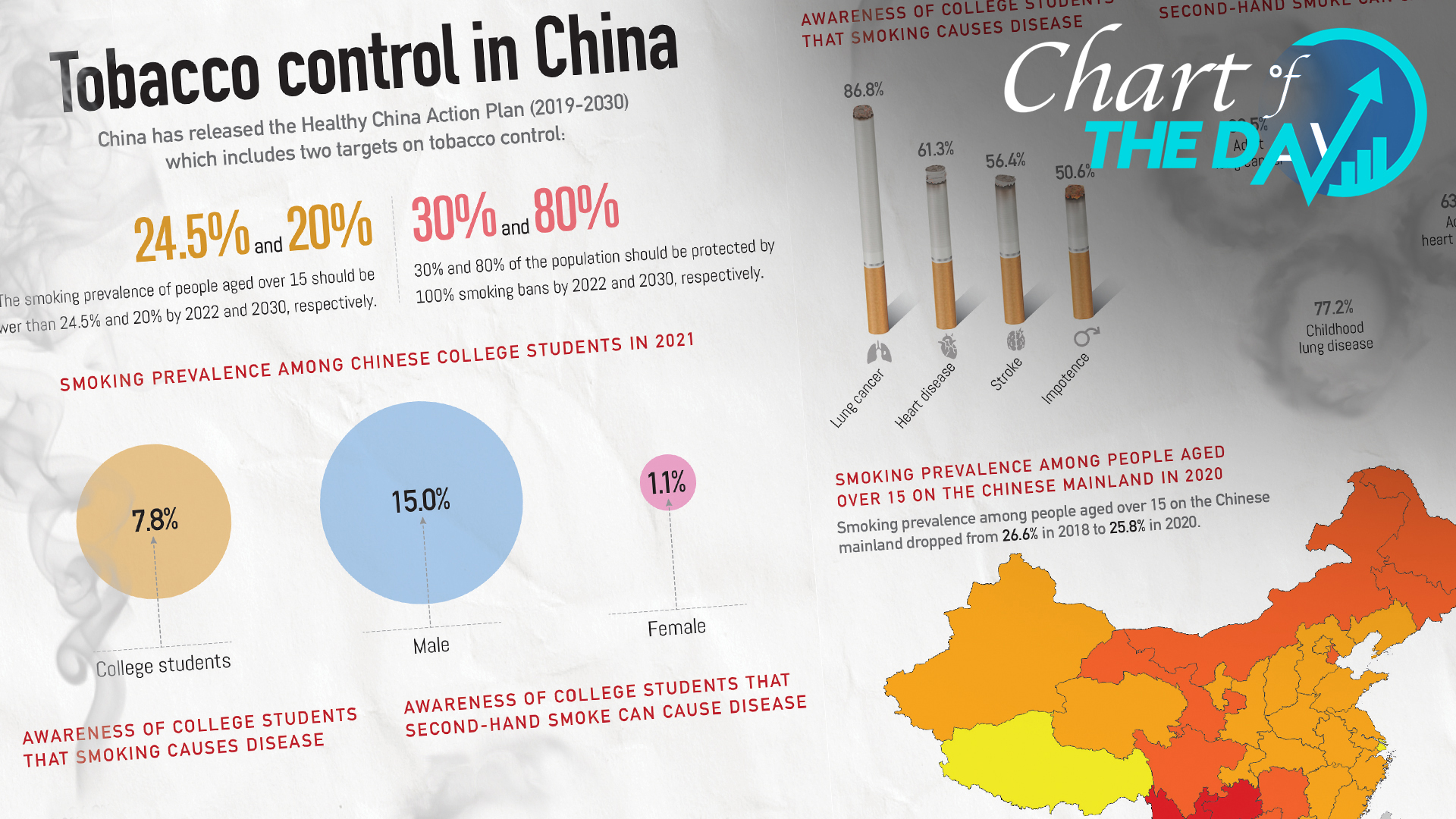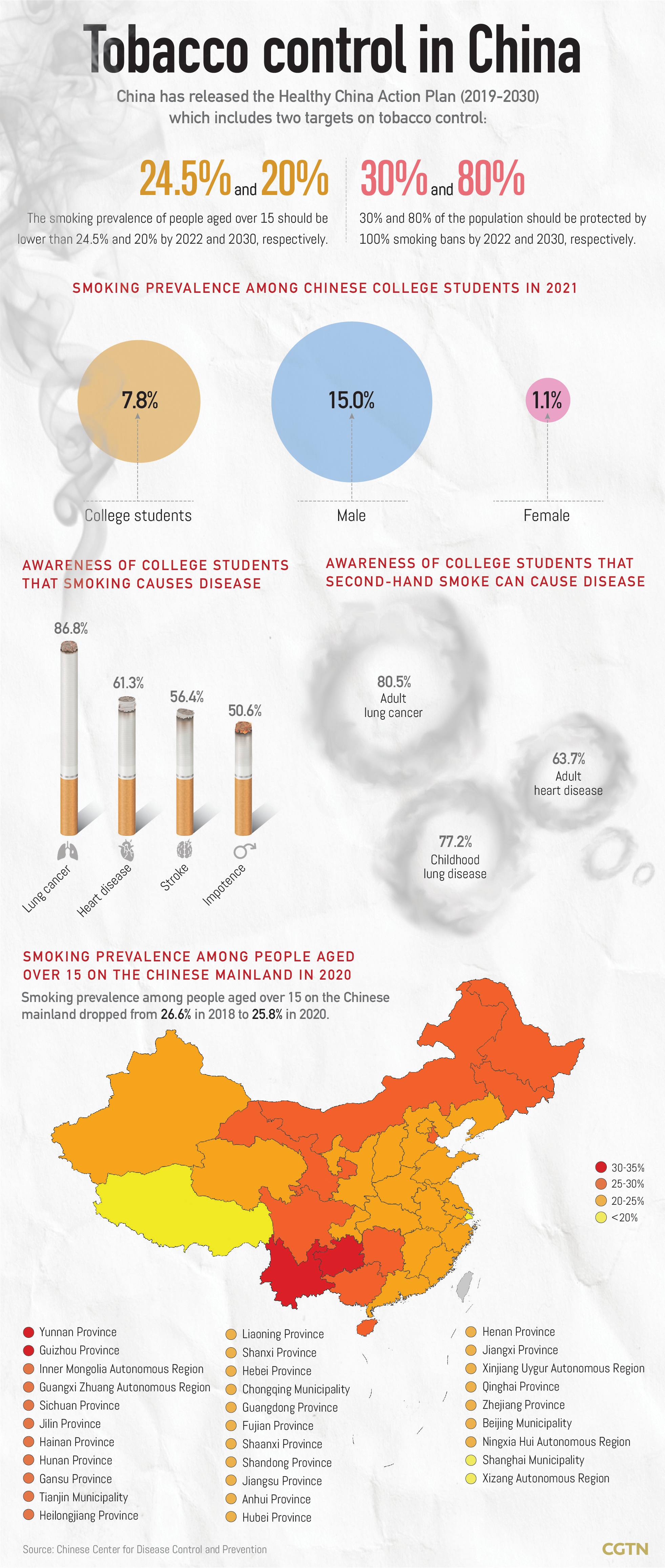
"About two years ago, I saw an 18-year-old patient who was in high school when his parents brought him to the smoking cessation clinic. He had been smoking since junior high school," Tan Xingyu, associate chief physician of the Department of Respiratory and Critical Care Medicine at Peking University People's Hospital, told China News.
"Fortunately, the boy's nicotine addiction was not so severe that he quit without medication," said Tan.
Tan, who has been offering her outpatient service every week since the hospital's smoking cessation clinic was set up in 2008, has supervised thousands of patients in the past 15 years.
Different from other outpatient examinations, Tan said patients who come to the smoking cessation clinic first need to fill out the tables to judge the degree of their nicotine dependence. Once they are judged to be moderately severe, they need drugs to help quit smoking.
What has impressed her most through the years is the changing age composition of the patients who come to consult her.
"Since the implementation of Beijing's tobacco control regulations (in 2015), we're seeing more patients than ever before," said Tan. "It used to be that people in their 60s and 70s came to quit smoking because of diseases like coronary heart disease. Now we see a lot of young people coming to the clinic without symptoms."
From the perspective of the doctor, reducing smoking rates among young people is the key to preventing more heavy smokers in the future.
Besides encouraging young people to voluntarily quit smoking, China has been promoting tobacco control through various other measures.
In 2019, the State Council launched the Healthy China Initiative, listing tobacco control as one of the 15 special campaigns to intervene in health-influencing factors. The outline for the initiative pointed to improving tobacco control by means of price, taxation and legal measures, and gradually banning smoking in all indoor public places.
A clear goal has been set to reduce the prevalence of smoking among people aged 15 and above to less than 20 percent by 2030.
To build a favorable environment for the young, China's authorities and departments have been focusing on smoke-free environment construction, related legislation, service system construction, education and guidance, contributing to an increasing number of people protected by smoke-free environment, and a drop in the secondhand smoke exposure rate of non-smokers, China Media Group (CMG) reported on Wednesday on the occasion of World No Tobacco Day.
Positive progress has been made, with the smoking rate among people over 15 dropping from 26.6 percent in 2018 to 25.8 percent in 2020, according to the National Health Commission.
Continuous monitoring with improving results

The Chinese Center for Disease Control and Prevention (China CDC) has been monitoring the use of tobacco and secondhand smoke exposure among Chinese adolescents since 2014.
In 2021, a total of over 136,000 junior high school students, 132,000 senior high school students and 124,000 college students took part in the survey.
The data showed that 4.7 percent of the high school students smoked in 2021, decreasing by 1.2 percentage points compared with 2019. The smoking prevalence among the college students was 7.8 percent, lower than that in the survey among those aged 15 to 24 years old in 2018 of 18.6 percent.
The survey also presented a decreased exposure to secondhand smoke in teenagers, with 56.4 percent of the high school respondents in 2021 reporting to have seen smoking behaviors at home, in an indoor or outdoor public place and on public transport in the past seven days, 10 percentage points lower than that in 2019, and 39.9 percent of them reporting to have seen smoking at school in the past 30 days, a decrease of 10.8 percent compared with 2019.
However, both the high school students and college students reported an increasing trend in e-cigarette use. In 2021, 2.5 percent of the college respondents used e-cigarettes, higher than the result in the 2018 national adult tobacco survey.
"Studies have shown that exposure to secondhand smoke in childhood may result in coronary heart disease in adulthood. Nicotine, the main ingredient in e-cigarettes, can also lead to addiction in teenagers," said Xiao Lin, deputy director of the tobacco control office of China CDC.
"In addition, nicotine may affect brain development of the teens, and studies have shown that e-cigarette use during adolescence can have an impact on their attention, emotion and learning ability," said Xiao.
Creating a tobacco-free society
Various measures can be taken to build a society free of tobacco, CMG reported, citing China CDC officials.
The first is to make the youth fully understand the severe harm of tobacco through education, convincing them to not even take the first puff.
Young people are encouraged to exert their influence on their peers to practice a smoke-free life and become promoters and advocates of smoke-free actions.
Relevant departments should implement the Law on the Protection of Minors and prevent the sale of tobacco products and e-cigarettes to minors, and introduce a comprehensive ban on tobacco promotion and sponsorship.
Any form of tobacco advertising is not allowed, and the censorship of smoking scenes in films and television programs should be strengthened to reduce the temptation for teenagers.
CGTN infographic by Yao Nian